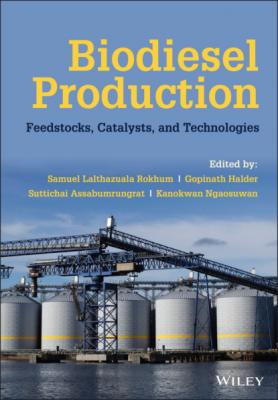ТОП просматриваемых книг сайта:
Biodiesel Production. Группа авторов
Читать онлайн.Название Biodiesel Production
Год выпуска 0
isbn 9781119771357
Автор произведения Группа авторов
Издательство John Wiley & Sons Limited
Library of Congress Cataloging‐in‐Publication Data
Names: Rokhum, Samuel Lalthazuala, editor. | Halder, Gopinath, editor. | Assabumrungrat, Suttichai, editor. | Ngaosuwan, Kanokwan, editor.
Title: Biodiesel production : feedstocks, catalysts, and technologies / [edited by] Prof. Samuel Lalthazuala Rokhum, National Institute of Technology Silchar, Department of Chemistry, NIT Road, Fakiratilla, Sichar, Assam, India, Prof. Gopinath Halder, Department of Chemical Engineering, National Institute Technology, Durgapur, India, Prof. Suttichai Assabumrungrat, Chulalongkorn University, Department of Chemical Engineering, Bangkok, Thailand, Dr. Kanokwan Ngaosuwan, Rajamangala University Technology Krungthep, Chemical Engineering Division, Krungthep, Bangkok, Thailand.
Other titles: Biodiesel production (John Wiley & Sons)
Description: Hoboken, NJ : Wiley, 2022. | Includes bibliographical references and index.
Identifiers: LCCN 2021056412 (print) | LCCN 2021056413 (ebook) | ISBN 9781119771333 (cloth) | ISBN 9781119771340 (adobe pdf) | ISBN 9781119771357 (epub)
Subjects: LCSH: Biodiesel fuels.
Classification: LCC TP359.B46 B5634 2022 (print) | LCC TP359.B46 (ebook) | DDC 665/.37–dc23/eng/20220228
LC record available at https://lccn.loc.gov/2021056412 LC ebook record available at https://lccn.loc.gov/2021056413
Cover Design: Wiley
Cover Image: © Julija Vidjajeva/Shutterstock
Preface
This book Biodiesel Production: Feedstocks, Catalysts, and Technologies includes the contribution of leading researchers in the fields of biodiesel, which will serve as a valuable source of information for scientists, researchers, graduate students, and professionals alike. It focusses on several aspects of biodiesel productions, technologies employed, and sustainability. It consists of 20 chapters, grouped together in three parts, in different technological aspects as follows.
The utilization of conventional and novel feedstocks for biodiesel production will be presented in Chapters 1–4.
Chapter 1 emphasizes on the conversion of several edible vegetable oils and animal fats to biodiesel. Different catalysts used and several factors that affect the overall biodiesel production are comprehensively discussed.
Chapter 2 provides the perspective of the biodiesel production from waste cooking oil via the conventional and modern technologies to bolster competitiveness of biodiesel with petrodiesel.
Chapter 3 addresses the state of the art and future perspectives of nonedible oils for biodiesel production. It provides several important aspects such as cultivation information, fatty acid composition, extraction, and conversion method for biodiesel production.
Chapter 4 proposes the important strategy of microalgae cultivation for the large‐scale optimization of lipid accumulation as a potential sustainable approach for biodiesel production.
In the next part, Chapters 5–14, the various types of homogeneous and heterogeneous catalysts for biodiesel production will be discussed.
Chapter 5 reviews the utilization of homogeneous catalysts for various feedstocks under optimum conditions to serve the growing demand of biodiesel as a cost‐effective production process.
Chapter 6 summarizes the development of metal oxide catalysts from various sources for biodiesel production. The reaction mechanistic pathways and causes of catalyst deactivation are discussed.
Chapter 7 focuses on the catalytic activity enhancement of metal oxides with particular focus on the role of supporters, their synthesis methods, and physicochemical properties to achieve eco‐friendly and economically viable processes of biodiesel production.
Chapter 8 highlights the development of new mixed metal oxides with a variety of novel acidic, basic, and bifunctional catalysts from various feedstocks for enhancing their catalytic performance. Their stability, catalyst regeneration techniques, and recommendation for full scale biodiesel production are also addressed.
Chapter 9 presents the outlook of using nanotechnology‐based catalysts for the development of more efficient, economically viable, durable, and stable nanocatalysts, targeting at achieving higher biodiesel quality and yields.
Chapter 10 reveals the advantages and issues of using ion‐exchange resins catalysts for both cation and anion exchange resins especially in continuous biodiesel production.
Chapter 11 discusses the solid bifunctional catalysts with acid–base and Lewis–Brønsted functionalities. The preparation methods, their characterization results, and the optimum condition for biodiesel production were addressed.
Chapter 12 proposes the green concept for biodiesel production using catalysts derived from renewable resources. Essential information on their preparation methods, physicochemical properties, and catalytic activities as well as the challenges are discussed.
Chapter 13 exploits the usage of the promising ionic liquid catalyst to replace homogeneously catalyzed biodiesel production concurrently with techno‐economic analysis, life cycle assessment, environmental impact assessment, and scale‐up technologies.
Chapter 14 demonstrates the effective acid/base metal–organic frameworks (MOFs) catalysts for both transesterification and esterification reactions to intensify biodiesel production based on their catalytic synergy.
The strategies in terms of upstream, mainstream, and downstream process to fulfill the economical and sustainable for biodiesel production will be addressed in Chapters 15–21.
Chapter 15 scrutinizes the strategies for upstream biodiesel production dealing with the advanced feedstocks like waste cooking oil, waste animal fats, nonedible oils, or genetically engineered oils based on the appropriate catalyst, reaction conditions, and the following downstream processes.
Chapter 16 approaches the operating key parameters of mainstream strategies in terms of the novel reactor for biodiesel production based on the scientific and practical viewpoints to achieve efficiency and sustainable concept.
Chapter 17 discloses the downstream strategies to accomplish biodiesel standard as well as operating cost

